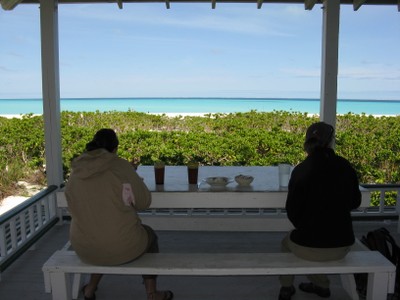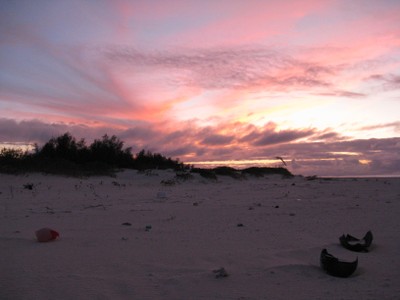Our adventures on Midway continued with story-time about amazing conservation successes and another incredible snorkel trip on the Atoll’s pristine reefs.
Day 8 on Midway did not disappoint. The sky-moos, bill-claps, and eh-eh bows from the thousands of albatross outside my Charlie Barracks Hotel window were just as loud as they’ve been everyday for the past week. Only, this time, I almost didn’t notice the racket when I awoke at 7 am.

I guess after only a week at Midway, hearing and seeing the albatross clatter seems almost normal. I have to keep reminding myself that when I go back home in 2 days, I’m not going to be greeted by the wonderful sounds of the Laysan mating dance. But, as I stumble down the path to the Clipper House for breakfast, I still cannot keep myself from stopping every 5 minutes to watch a parent caress its chick, a pair dancing away, or a happy mother smiling on her nest waiting for her precious egg to hatch. OK, I admit it. Like everyone else, I’ve fallen in love with albatross.
The albatross and most of the other 125 native birds that call Midway home for at least part of the year seem to be pretty happy here. They owe their happiness to all of the folks that dedicate their lives to protect, preserve, and enhance the biodiversity of Midway National Wildlife Refuge.

These people include the staff of theUS Fish and Wildlife Service (FWS) that manage the refuge, as well asChugash Alaska Corporationemployees who are contracted by FWS to run operate the infrastructure on the Atoll. The 60 residents on Sand Island do an amazing job to keep the wildlife happy.
Jack-of-all-trades
This morning we visited the FWS office to hear from John Klavitter, the wildlife biologist aka Jack-of-all-trades on Midway. John explained many of the conservation and management challenges that he faces in trying to enhance the habitat and biodiversity on Midway, and we learned that John is a true decathlete when it comes to solving the problems that arise. Not only does John do hard-core wildlife biology research as he was trained to do, but he also puts on many different hats including: construction worker, engineer (check out the video to see a good example of this), hunter (for nasty invasives only), gardener, and even heavy machinery operator (which he highly recommends trying by the way). I really don’t know how he does it all, but he has greatly contributed to conservation on Midway since arriving here 7 years ago.
One of the most exciting conservation success stories in which John played a vital role was the reestablishment of the highly endangered Laysan Duck on Midway. Laysan Ducks originally inhabited all Hawaiian Islands, but were restricted to Laysan Island in the Northwestern Hawaiian Islands chain by 1900 because of humans and disease. Rabbits were introduced to Laysan Island as a protein source for villagers that lived there, and they ended up multiplying (like rabbits) and eating all of the native vegetation, thereby destroying Laysan Duck prime habitat.

By 1911, only 11 ducks were left on the island including only one breeding female! The rabbits were then eradicated from Laysan and from that one breeding female, the population grew to 600 by 1993. Later, a drought on the island caused a parasite outbreak which once again reduced the population to only 100, so a team of biologists including John decided to establish a second population on Midway in 2005. John led the charge to create freshwater seeps for the ducks on Sand and Eastern Island and ever since then, the population’s been thriving! (seeMichelle’s blog for more info)
The Single Greatest Conservation Achievement on Midway
As you’ve learned from Michelle’s and Anna Marie’s blogs, invasive species such as the Golden Crownbeard can pose many problems for the birds on Midway. Of 267 total plant species on Midway, only 15 are native. The FWS therefore dedicates a lot of time and effort to killing and removing as many of these invasives as possible. Currently, only one land mammal (which is non-native) exists on Midway, the House Mouse (Mus musculus). But it wasn’t always that way! The eradication of the Black Rat (Rattus rattus) from Midway by the Navy in 1997 was, according to John, the single greatest conservation achievement on the atoll. In the 1940s, the Black rats were introduced accidentally to Midway as stowaways on cargo ships. They caused havoc as soon as they arrived, eating chicks, eggs, and even adult birds. By 1945, they also caused the extinction of the Laysan Rail (Porzana palmeri), a flightless bird endemic to Laysan Island that also was established on Midway. The Navy therefore decided to fund an eradication program in 1994, using Japanese basket traps and bait stations, placed 100 feet apart all over the islands. It took $1 million and 3 years to get rid of the rats on Eastern, Spit, and Sand Islands , but it was worth it. We wouldn’t have the incredible numbers of seabirds nesting on Midway that we do today if it weren’t for the Navy’s rat eradication program. Luckily, the House Mouse isn’t quite as devastating as the Black rat was, but it does eat many of the native vegetation seeds, making FWS’s job of reestablishing native vegetation even harder. Unfortunately, FWS does not currently have the funding needed to eradicate the mice as well, but hopefully one day they will!
Food Glorious Food
After our fascinating talk with John at FWS, we made our way over to the Clipper House for an incredible lunch of thai curry and fresh salad with hydroponically grown lettuce. The Clipper House’s head chef Pong Wichasawatdi, from Thailand, treats us extremely well.

He comes out to greet us at all meals, and makes sure that all of us (including the herbivores) are happy and well-fed. And believe me, we are WELL fed. Pong’s curries and soups are unbelievable…with just the right amount of spice to put hair on your chest. Luckily, there’s even a soft serve ice cream machine to help us wash it all down, not to mention the amazing view from the Clipper House, where we often get daily appearances on North Beach of a Hawaiian Monk Seal. The island residents have already warned us about the weight gain…but it’s all worth it for Pong’s deliciousness. Watch the video to get a real taste for our dining experience on Midway.
Snorkeling Trip Number 172
Ok, we really haven’t gone snorkeling 172 times since we got here (I wish), but this afternoon we snorkeled at spot 172 or Purple Reef, on the eastern side of the Atoll. Although the weather wasn’t quite as lovely as we’d hoped, we braved the drizzle and made our way out to the reef, with our trusty boat driver John Miller from FWS as our escort. On the way out, the friendly resident Spinner Dolphin pod that we’ve been seeing each day joined us for a brief hello and a couple of spins. As we sped across the deep lagoon in the middle of the atoll to shallower water, there was a distinct color change from deep blue to bright turquoise. It looked like we were flying across an enormous swimming pool. The water was crystal clear, and as we anchored close to the atoll rim, we could see the coral and fish moving below us without even putting on our masks.
Jack #2
The water was chillier than snorkel trip number 1, around 65 degrees F. The sun came out just as we anchored, but we still had to keep moving once we entered the water in order to retain a little heat. We saw amazingly beautiful corals: the purple coral was so bright that it even glowed in the sunlight. We also saw myriads of colorful Hawaiian reef fish, including Parrotfish, Squirrelfish, Spotted Puffer, Needlefish, and CornetFish.


But, the favorite fish of the day was the Ulua– the Hawaiian name for the Black Jack, or Black Trevally. TheUlua is a large, silvery-gray fish that has very distinct fins and looks at you with a frown. The visibility at this spot was incredible: likely the best I’ve ever had when snorkeling or diving. We all stayed in as long as we could (about 45 minutes), although there were some casualties as Anna-Marie and Mike’s fingers and toes turned white and numb from the cold water. See? It’s not all fun ALL the time out here…
Our first real Sunset
We finally got a chance to watch the sunset on Midway. After dinner, we strolled the beach, looking for glass Japanese fishing balls to no avail. We did, however, find plenty of marine debris on the beach, including a no parking sign and a bike seat. It’s crazy what treasures Midway collects from the North Pacific Gyre, and even crazier to think that they are coming from as far away as Asia or the Americas. It’s time, I think, for all of us to make a concerted effort to reduce, reuse, and recycle as much of our waste as possible.

